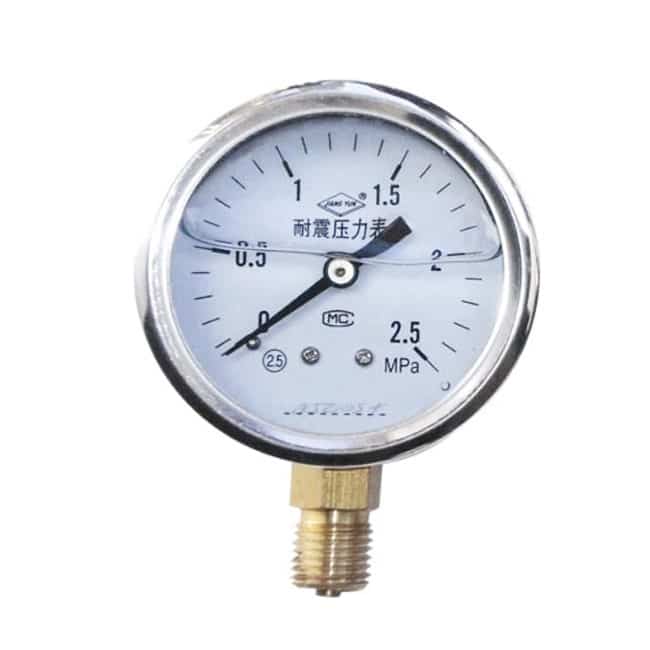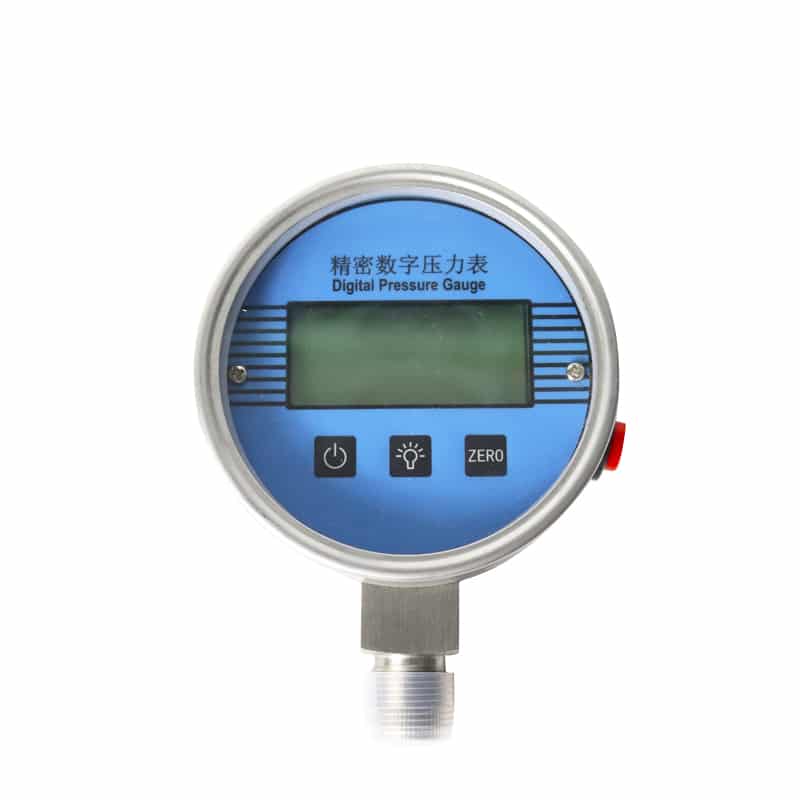Pressure Gauge
Pressure gauge refers to the elastic element as a sensitive element, measuring and indicating higher than the environmental pressure of the instrument, the application is very common, it almost throughout all industrial processes and scientific research fields. It can be seen everywhere in heat pipe network, oil and gas transmission, water and gas supply system, vehicle maintenance factories and shops. Especially in the process of industrial process control and technical measurement, the mechanical pressure gauge is more and more widely used because of its elastic sensitive element with high mechanical strength and convenient production.
What is pressure gauge?
Pressure gauge is an instrument designed to measure the pressure of a medium in a system.
Measuring the pressure in a system is a critical quality step to ensure product consistency and safety checks to understand leaks or build up pressure in the system. It is important to understand the basic principles of pressure before specifying a pressure gauge. The correct pressure gauge can then be determined based on selection criteria to accurately measure the pressure in the system. Even the best measuring devices will deviate from the actual value. It is important to understand how this measurement accuracy is defined. Digital gauges offer a higher degree of accuracy than analog gauges.
How does a pressure gauge work?
Pressure gauge through the elastic deformation of the sensitive elements (Bourdon tube, diaphragm box, bellows), and then the pressure deformation is transmitted to the pointer by the conversion mechanism of the movement in the table, causing the pointer to rotate to display the pressure.
Pressure represents the magnitude of the force applied per unit area perpendicular to the surface. In a stagnant liquid or gas, this is the magnitude of the force applied to the wall of the vessel at a given point.
The static pressure is uniform in all directions. However, a moving fluid exerts an additional pressure in the direction of flow with negligible effect on the surface parallel to the direction of flow. This additional pressure is called dynamic pressure. The total pressure of the flow (also called the stagnation pressure) is the sum of the static and dynamic pressures in that flow.
If the instrument is oriented in the direction of flow, it will measure the total pressure of the flow. The instrument discussed here is designed to measure the static pressure in the system.
Pressure is usually measured in three forms.
- Absolute pressure represents the total force per unit area. The absolute pressure of a perfect vacuum is zero, while the absolute pressure of the earth’s atmosphere at sea level is 1 atmosphere.
- Gauge pressure is what most pressure gauges indicate, and it is the pressure of the medium relative to atmospheric pressure. This means that the gauge pressure is the absolute pressure minus the atmospheric pressure. If gauges are designed to measure pressures less than atmospheric pressure (called vacuum pressure), they may be marked as “vacuum gauges” and negative values may be omitted. To indicate that the pressure measurement is relative to atmospheric pressure, the letter “g” follows the unit pressure, for example 50 psi g.
- Differential pressure is simply the difference in pressure between two given points. Some gauges provide this measurement for convenience, since it is not necessary to subtract two pressure readings from the system.
Types of pressure gauge
Borden Tube Type
A Borden tube is a flat, thin-walled, closed-end tube formed in a C-shape or spiral. When fluid pressure is applied inside this tube, the oval cross section of the tube becomes more circular, straightening the tube. When the fluid pressure disappears, the tube will regain its shape. The change in shape of this tube creates a pattern of motion at the free end of the tube that translates into pointer rotation with a linkage and gear.
Borden tubes measure gauge pressure (relative to atmospheric pressure). The Boden tube is the most commonly used type of pressure gauge because of its excellent sensitivity, linearity and accuracy.
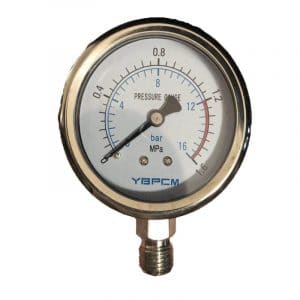
Applications
Borden tube gauges are available in a variety of designs and features to serve a wide range of applications. Borden tube gauges are available in pressure ranges from 0 to 0.6 bar to 0 to 1600 bar, and accuracy ratings typically range from 0.1 to 4.0.
Diaphragm Type
Diaphragm pressure gauges use a deflection of a flexible membrane that separates the two environments. One side of the diaphragm can be exposed to atmosphere, in which case gauge pressure is measured, or it can be sealed to prevent a vacuum, in which case absolute pressure can be measured.
The diaphragm is usually metal or ceramic and can be sandwiched between two flanges or welded. As the pressure increases, it bends the diaphragm, which can be converted to a dial measurement by using gears and linkages.
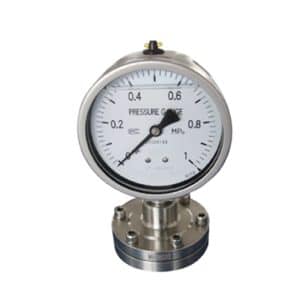
Applications
Diaphragm pressure gauges are suitable for corrosive gases, liquids or high viscosity media. This type of gauge is widely used in the chemical/petrochemical, power station, mining, onshore and offshore, and environmental technology industries. The measuring range of these gauges is between 0 … 2.5 mbar and 0 … 25 bar, and the accuracy class is usually between 0.6 and 2.5.
Capsule Element Type
The capsule element pressure gauge is used to measure air and dry gases at low pressures. The gauge consists of two circular diaphragms connected along their outer edges. One of the diaphragms has an opening in the middle to allow the medium to enter.
The expansion or contraction of the chamber allows for pressure measurement due to the pressure difference between the external and internal media. A pressure gauge that works in a similar way is a bellows pressure gauge.
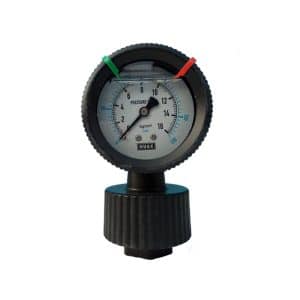
Applications
These gauges are used almost exclusively for precise pressure measurement in gaseous media. They are most prevalent in low pressure pneumatic systems, venting valves, overpressure monitoring, filter monitoring and vacuum pumps. Most of these gauges typically measure from 0 … 1 mbar to 0 … 600 mbar, with accuracy ratings typically between 0.1 and 2.5.
Mounting and connection types
- Standard threaded connection: This type of instrument simply screws into the available threads. The threads are sealed with compression seals for tapered threads and O-rings for parallel threads.
- Integrated Gauge: This gauge installation consists of a female threaded mounting.
- Flange Pressure Gauge: This mounting is for those who wish to mount the gauge to the control cabinet.
Accessories
A variety of accessories are available for use with pressure gauges. Common ones are:
- Seals/Gaskets: These ensure that a proper seal is made.
- Flat: Seals are flat and do not allow additional rotation of the gauge reading.
- Contoured: Seals are contoured to allow the gauge reading to be rotated 1/2 turn or a full turn to ensure proper installation orientation. Profile seals can be centered externally or internally.
- Safety Cap: A rubber cap is placed over the gauge for added durability and shock absorption.
- Reducers: Reducers may be used if the input and output connections to the pressure gauge are different sizes. Also useful if the two have different connection types (i.e., BSPP and NPT).
- Push-on connectors: Allow for quick and easy installation or uninstallation of hoses on pressure gauges.
- Snubbers: Pressure snubbers dampen the effects of pressure spikes and pulses, keeping the gauge readable and extending its life.
Selecting the right pressure gauge
When selecting a pressure gauge, several factors need to be considered:
Pressure Range: A gauge range of twice the working pressure is generally recommended for maximum accuracy, safety, and extended gauge life. Working pressure should always be limited to 75% of the gauge pressure range. When pressure pulsations are encountered, the working pressure should be limited to two-thirds of the gauge pressure range.
Temperature Range: Soft soldered Apure general purpose equipment gauges are limited to a maximum temperature of -40ºF to 120ºF. Silver soldered or welded Apure process gauges are limited to a maximum temperature of -40ºF to 190ºF and Apure liquid filled gauges are limited to a maximum temperature of 0ºF to 140ºF.
Conditions affecting system wear: In applications involving severe pressure fluctuations, vibration and/or pulsations, the use of flow restrictors or pressure buffers is recommended. In addition, fluid-filled gauges should be considered. A fluid fill will lubricate movement and reduce friction and wear. Liquid filling will also prevent moisture or corrosive atmospheres from affecting the inside of the gauge.
Pressure Fluid Composition: Since the sensing element of a pressure gauge may be directly exposed to the medium being measured, consider the characteristics of that medium. It may be corrosive, may be a gas or liquid, may solidify at different temperatures, or may contain solids that will leave deposits inside the sensing element. For pressure fluids that do not solidify or leave deposits under normal conditions, a Boden tube pressure gauge may be used. A diaphragm chemical seal should be considered when the gauge wetted parts are incompatible with the medium being measured.
Pressure Range: A gauge pressure range of twice the working pressure is generally recommended for maximum accuracy, safety, and extended gauge life. Operating pressure should always be limited to 75% of the gauge pressure range. When pressure pulsations are encountered, the working pressure should be limited to two-thirds of the gauge pressure range.
Pressure Fluid Temperature: Steam and other hot media may raise the temperature of the gauge components above the safe operating limit of the sealed joint. In these cases, it is recommended that siphon or chemistry diaphragm seals be used with the gauge. Chemistry diaphragm seals and remotely armored capillary tubing may also be considered for use with gauges subjected to very low or high ambient temperatures.
Environmental Conditions: Normal ambient temperature range for Apure general purpose equipment gauges (soft solder) is -40ºF to 120ºF; for process gauges (silver solder/solder) -40ºF to 190ºF; for liquid filled gauges, 0ºF to 140ºF. The error due to temperature change is approximately ±1% for every 50ºF change. The reference temperature is 75º F. Remote mounting of gauges using chemistry diaphragm seals and capillary lines is an alternative method for applications involving extreme ambient temperatures. Moisture and weather effects must also be considered. A liquid-filled gauge will prevent condensation buildup. For outdoor use, gauges with stainless steel, brass, or plastic housings are recommended. Mechanical shock, vibration, dust, and humidity are some other considerations when selecting a gauge.
Mounting: Most Apure gauges are available with undermount and center-back or under-rear mounting. apure products have standard NPT threaded connections. Other types, such as metric threads, straight threads, hose barbs and other special fittings are available as special orders. Apure gauges are calibrated in the vertical, upright position and should be installed as such. For applications where the gauge is mounted horizontally, horizontally, or upside down, the gauge should be recalibrated in the end-use position.
Required Accuracy: Apure manufactures gauges with an accuracy of ±3-2-3% to ±.25% of full scale. Typically, more accurate gauges have larger dial diameters and are more expensive.
Housing Venting: Apure liquid filled gauges have a flexible vent/fill plug tip that can be easily cut (after installation) to allow housing venting. This is recommended for all liquid-filled gauges, especially those with maximum pressure ratings of 100 psi and below. This will compensate for atmospheric changes that may affect the calibration of the fill gauge.
Applications
Applications in Industrial Production
- Boiler: Monitor the steam pressure in the boiler to ensure safe operation.
- Compressor: Measure the pressure of compressor outlet gas, control the compression ratio.
- Hydraulic system: Measure the pressure of hydraulic oil, control the action of hydraulic system.
- Pneumatic system: Measure the pressure of compressed air, control the operation of pneumatic components.
- Chemical production: Measure the pressure in the reactor and storage tank to ensure the safety of the production process.
- Oil and gas: Measure pressure in pipelines and storage tanks to control transportation and storage.
Application in scientific research experiment
- Physics experiment: Measure the pressure of gas to study the properties of gas.
- Chemistry: Measurement of pressure in reaction vessels to study the reaction process.
- Material science: Measurement of compressive strength of materials.
Applications in daily life
- Automobile: Measure tire pressure to ensure driving safety.
- Household appliances: Measure the pressure in refrigerators, air conditioners and other equipment.
- Medical equipment: Measurement of blood pressure, blood oxygen and other physiological parameters.
Special applications in different industries
- Aerospace: Measurement of pressure in rocket engines and airplane cabins.
- Food & Beverage: Measurement of pressure in filling equipment to ensure product quality.
- Water treatment: Measurement of pressure in pumps and pipelines.

